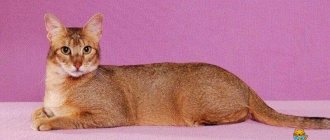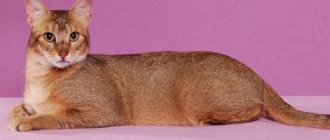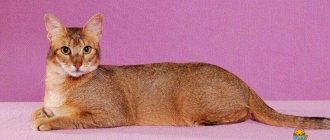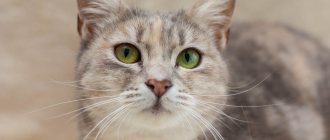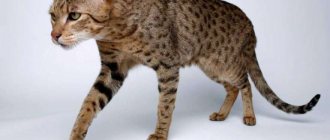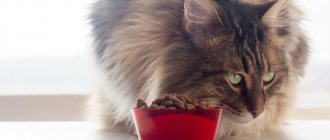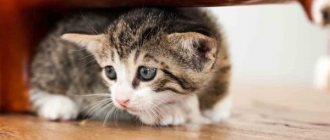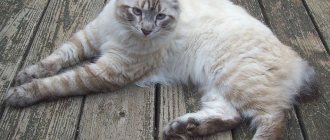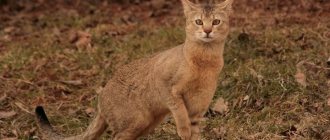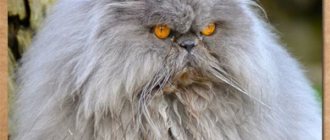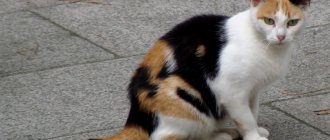Chausie are domesticated descendants of predatory inhabitants of swamps, rivers, and lakes. These proud creatures are the embodiment of animal energy, power, partly curbed by man. Such cats are more likely natural hunters than affectionate purrs. This is also facilitated by their charming appearance, which is distinguished by the special grace of a wild representative of the cat world. Due to its unusual exterior and combination of contradictory behavioral traits, the breed of reed cat descendants is considered one of the most expensive in the world.
Origin
The uniqueness of the Chausie F1 breed is emphasized by its very origin. Chausie F1 appeared as a result of crossing the exotic cat Jungle Cat and a cat of the traditional Abyssinian breed. Let us note that such a union is a very rare phenomenon, and now breeders have to make a lot of effort to “make friends” of such different pets.
Be that as it may, such a meeting took place, and the unusual-looking cats drew the attention of one inquisitive American tourist, who visited the Middle East in the 60s in search of exotic experiences. The result of his interest was the fact that the first F1 Chausie (chausie) were bred in the USA. And in the 90s, the new breed was already registered with TICA (The International Cat Association), and quickly found its fans.
Chausie F1 got its name from the Latin name of Jungle Cat's dad: Felis Chaus. The index “F” in the name of the breed means the following:
F1 - the father was Jungle Cat (the largest kittens in size, with at least 50% Jungle Cat blood);
F2 - at least 25% Jungle Cat blood;
F3 - at least 12.5% Jungle Cat blood (kittens the size of a regular domestic cat), etc.
Description of chausie
The tame predator looks like an Abyssinian on steroids. Cats of this breed are much larger than other cats. Sometimes their weight reaches 15 kg, but on average the pet’s weight is 7-10 kg. The body of males is more massive, but females are much more active.
The pets of this breed inherited the structural features from their “relatives” - savages. Chausie cats have an elongated, powerful, elegant body with a deep chest. The animal radiates with energy, making it look like a compressed spring. The limbs are tall, slender, strong with large pads. The hind legs are longer than the front legs, so these cats can jump up to 2 meters in height. But the thick tail turned out to be unexpectedly short relative to the length of the body.
A medium-sized, oval-shaped head with a developed chin and wide, slightly pointed cheekbones sits firmly on a stocky, muscular neck. The Egyptian gracefulness of the Chausie is partly due to its large ears and elongated, panther-like muzzle. The nose is straight and wide. The ears are large, set wide apart, pointed at the ends, and decorated with thin tassels.
According to the standard, Chausies have large, slightly slanted, round eyes. The amber tint of the iris looks the most beautiful and harmonious, but there are combinations of yellow and green shades. The eye color of exotic Americans contrasts favorably with the coat color.
The Hausi's fur coat is very short and full. The luxurious cover went to the marvelous descendants of wild cats from the Abyssinian breed. The fur is shiny, shimmering under the rays of the sun with warm, bright sparkles. It feels soft and elastic to the touch.
color palette does not offer much variety. The standard establishes only three acceptable shades of coat: black (with an admixture of gray), silver-brown ticked and dark ticked tabby. Due to the novelty of the breed, more and more different coat colors are appearing, but they are in no hurry to add them to the main ones. For this reason, such kittens cannot participate in exhibitions.
When buying a pet, there are a few more subtleties to consider. Firstly, regardless of coat color, the tuft on the tail and small bushes of hair on the tips of the ears should be exclusively black. Secondly, the pattern of the fur coat can be blurry, but the pattern on the tail, paws and head is clear, the neck and chest are usually decorated with a light shirt-front.
The most important factors determining the inherited exterior and character of a Hausie are the degree of relationship with the jungle cat and the percentage of its blood in the total volume.
For example,
- chausie F1 - at least 50% wild blood / father;
- chausie F2 - at least 25% / one of the progenitors - “savage”;
- chausie F3 - about 12.5%, etc.
The higher the indicator, the closer to the “roots” the pet is considered.
Kinds
The Chausie breed is divided into several hybrid varieties, which are marked with the letter F and numbers from 1 to 5. The number after this letter shows the percentage of the blood of the dad - a jungle cat in the hybrid. The higher the numbers, the less “reed” blood.
The hybrid Chausie F1 is the most valuable and most expensive descendant, the first branch from the combination of House and a noble cat (by the way, in addition to the Abyssinian breed, the participation of a short-haired European breed is acceptable in the mating). About 50% wild blood, almost a copy of dad in appearance, and his temperament is also his, he is active, can occasionally show disobedience and even aggression. The size is large. It is also marked with the letter A.
The F2 hybrid is obtained from the combination of F1 with any descendant of the Chausie, it must contain at least 25% of the blood of a wild cat. This breed is the most popular, it has a large weight (up to 10 kg) and a democratic character. Marked as group A or B.
An F3 hybrid is the result of combining any type of Chausie with an F2 hybrid. “Reed” blood should be about 12.5%. The size is almost like that of a domestic cat, its character is soft, its color and appearance are similar to its wild ancestor.
Hybrids F4 and 5 contain a percentage of wild animal blood of 6.25% and 3.12%, respectively. These creatures are absolutely domestic, normal size, standard build. They are marked with the letter C or SBT, that is, descendants of the fourth and further generations after crossing with House. The resulting crossbreeds, depending on external data, can be used for mating with F1 and F2, or removed from breeding. The Chausie cat is considered a young hybrid breed; it constantly needs a “rush of wild blood.”
A little about the “parents” of the F1 chausie:
The jungle cat is a predatory wild feline animal, about 60-90 cm in length, weighing from 8 to 12 kg. The body is relatively short, the legs are high, the tail is short (21-30 cm), and there are small tufts on the ears. It lives near the banks of rivers, seas and lakes, in reed thickets or thorny bushes.
Tries to avoid open spaces. In our country it is found on the plains of Dagestan, on the coast of the Caspian Sea, and reaches the Volga. In the direction of the Terek and Kuma rivers it reaches Stavropol and North Ossetia. Also lives in Transcaucasia and Central Asia. Listed in the Red Book of the Russian Federation.
The Abyssinian cat is a noble breed that received official registration at the end of the 19th century in the United Kingdom. Cat breeds from Southeast Asia and Africa were taken for breeding. One of the first officially registered breeds. Slender, light, medium in size, weighs from 3 to 6 kg.
Satin silky coat, interesting color. Recognizable not only by its figure and color, but also by the white border of light hairs around the eyes, which gives expressiveness to the look and visually “opens” the eyes. The cat is a legend from African fairy tales, distinguished by intelligence and observation. The character is lively and sociable.
Advantages and disadvantages
| pros | Minuses |
|
|
Chausie is included in the ranking of the most expensive and exotic breeds. This miniature copy of a wild cat will become a worthy friend for humans and will be able to find a common language with other animals.
Brief description of the breed
What is the actual country of origin?
USA
When did the breed appear?
2003
How long does he live?
from 12 to 15 years
How much does a cat weigh?
from 10 to 15 kg
How much does a cat weigh?
from 9 to 13 kg
How tall is the animal?
from 40 to 50 cm
How long is the animal with a tail?
up to 155 cm
How much does a kitten with documents cost?
from 600 thousand to 1.5 million rubles
What is the price of a kitten without documents?
from 30 to 600 thousand rubles
Appearance
Chausie F1
The appearance of the representatives of the breed is worthy of praise from cat lovers from all over the world. Chausie - moderately muscular animals with a proportionally built body - are very similar to their distant ancestors. Despite inbreeding with the Abyssinians, the cats managed to maintain impressive dimensions: a weight of 14-15 kg and a height at the withers of up to 40 cm.
The Chausie is classified as a medium-sized short-haired breed. They are distinguished by pronounced sexual dimorphism: males are 15-20% larger than females.
Head and skull
The cat's head is distinguished by the shape of a wedge or, as it is also called, an elongated triangle. Moderately elongated, but looks small in comparison with the body of the Chausie. It has graceful outlines, no angularity. The forehead is flat and wide, the occipital protuberance is slightly pronounced. The skull is rounded.
Muzzle
The neat and small muzzle of the animal is composed of smooth lines. Stop – the transition from the nose to the forehead is quite sharp. The bend of the high cheekbones in the direction of the cheekbones is also noticeable. The nose and chin of the Chausie form a straight line. It is noteworthy that the width of the bridge of the nose depends on the gender of the animal: in cats it is narrower. The lobe is convex.
Ears
Chausie F2
Large ears with a wide base are set high, almost on the top of the Chausie's head. The distance between the “triangles” is significant. The reverse side of the ears is decorated with false “eyes” - spots that the cat inherited from its distant ancestors from Egypt. The tips of the ears are pointed and crowned with small tassels. The presence of the latter is welcome, but the absence is not regarded as a breed defect.
Eyes
The almond-shaped eyes of the Chausie are set quite close, slightly slanted. Amber or deep yellow pigmentation is preferred. Variation in the shade of the iris within the yellow-green palette is acceptable.
Jaws and teeth
A cat's developed jaws form a scissor or level bite.
Neck
Muzzle of a Chausie cat
The thick and short neck of a Chausie does not look awkward and allows the animal to maintain harmonious body proportions.
Frame
Chausie kitten
The cat's tightly built and heavy body has superbly developed muscles. As Chausie owners are used to joke about their pets: “It’s like an Abyssinian on anabolic steroids!” The animal's chest is quite deep and wide, which contrasts with the cat's narrow shoulders and pelvis. The back is straight, the underline is moderately tucked.
Tail
The Chausie's straight and flexible tail is notable for its lack of kinks. Wide at the base and quite mobile, making up ¾ of the body length.
Limbs
The animal's legs provide powerful propulsion, so don't be surprised if your pet can easily jump onto the highest shelf in the closet. The muscles are well developed. The Chausie's paws are large, but despite this, they look compact. Fingers are not tightly gathered.
Coat
The short fur fits tightly to the body of the animal. Elastic hairs have a healthy shine. The undercoat is developed. The guard hair is ticked (unevenly colored) in at least two places.
Color
The Chausie breed standard provides for three main colors:
Chausie kitten F2 black and silver color
- black. The cat's fur is evenly colored, there are no marks;
- black ticked tabby. The hairs are colored with two or three stripes. The undercoat has a golden-red hue. The points are located on the tail and inside of the Chausie's paws; on the body they are unacceptable. The chin and eye rims are highlighted;
- black and silver ticked tabby. The guard hair has two or three ticking stripes of silver and black colors. The tips are always painted in a dark shade. Pronounced tabby points are undesirable.
Possible defects
A Chausie breed defect is any deviation from the standard. Among the main ones are:
- small, close-set ears;
- atypical pigmentation of the iris;
- poorly filled chest;
- clearly rounded head shape;
- excessively elongated neck;
- weak stop;
- hunchback.
Animals are disqualified for the following reasons:
- short tail (less than ¾ body length);
- white points on the body;
- amputated claws;
- congenital deafness;
- undescended testicles.
Breed standards
- The physique is powerful, but without thickening.
- Angular cheekbones and a strong-willed chin on a neat small head.
- A prerequisite is that large ears should be set high and thick at the base. Tassels on them are welcome, but this is not an “iron” condition.
- The paws are elongated and strong, the “slippers” on the paws are large.
- The tail must be ¾ the size of the body.
- The fur is short, thick and dense. The word “stuffed” applies to it
- Comparable in size to a Maine Coon, height - up to 40 cm at the withers, weight 7-15 kg. The heavier the cat, the more “reed” blood it contains.
- According to the standard, three types of color are accepted - black, as well as tabby* and silver ticked**.
- Regardless of color, the end of the tail and the tips of the ears with tassels are exclusively black.
- On the body the design is unclear, but on the “face” the letter “M” is obligatory, and on the neck there is a transverse line in the form of a necklace.
A little about the terms used to describe the color of Chausie cats.
*Tabby is another word for “wild”, a color with a pattern on the coat. It is believed that this is the natural coloring of all cats. A distinctive feature is dark stripes on the face, beautifully bordering the eyes in the shape of an “M” on the forehead.
Almost all wild cats have a coat color that allows them to skillfully camouflage themselves in nature. Most often, “camouflage” is a striped or spotted color that hides them well in the grass and among trees. As a result of human selective breeding, many other cat colors have appeared, but the tabby is still recognized as the most intricate and widespread.
In nature, it is found only in cats; no one else has such a pattern in the animal world. And no two identical colors can be found in nature. But we can identify common characteristics of all tabbies:
- obligatory “scarab mark” on the forehead (drawn dark mark in the form of the letter “M”;
- “necklace” on the chest of continuous dark stripes;
- “bracelets” on the limbs in the form of ring-shaped dark stripes;
- “medallions” in the form of spots on the animal’s belly, they are arranged in rows;
- good clarity of the picture, no blurry stripes;
- edging around the eyes to match the main predominant color;
- eyes of silver colors are all shades of green; for all others - in yellow tones (copper, bright orange, lemon, amber, etc.)
**Ticked color – zonal hair coloring. It is sometimes called the Abyssinian color. This is one of the varieties of tabby (ticked tabby) - a different color without a specific pattern. Each hair is colored with transverse stripes - dark-light-dark. At least three dark ones. It turns out small ripples on the fur, like scattered freckles. There is a faintly drawn "M" on the forehead. And an almost invisible pattern on the paws and chest.
Now let's return to our three colors accepted for the Chausie breed.
Black Chausie - “cat-night”. The color of the fur coat is coal black with a silver tint. There is a feeling that this wool looks like a velvet cape with a precious coating.
Ticked tabby or ticket tabby - “sun cat”. The color of the skin is fawn with red and cream highlights. Dark ticking gives the fur a slightly “predatory” appearance. If you light this cat from behind, you can see a luminous border around it, like a halo around the sun.
Ticked silver or silver ticket tabby - “moon cat”. Anthracite colored wool with pearl tips. Very close to the colors of the reed “ancestor”. It is perhaps the most valuable of the colors.
Minuses:
- Chausie is a very rare, and therefore very expensive, breed. The price of the first generation Chausie is in the thousands of dollars. Comparable to the cost of the car. One of the five most expensive cats in the world.
- There is also a tactful point that is considered a minus. Expensive breeds that have a lot of wild cat blood do not “respect” the litter box. The owner needs to muster the will and patience to convince him. Or let it out into the yard if you have a private house.
Character and behavioral characteristics
The Chausie cat, despite its wild roots, grows up to be a cheerful and sociable animal. With proper care and education, the owner will receive a devoted and well-mannered friend.
Relationship with the owner
Ragdoll (cat): description of breed and character
Cats are affectionate with their owners and always show tenderness in response to stroking. They can purr and follow a person's heels. In addition, they are independent animals, inquisitive and love to explore new territory, so they will always find something to keep themselves busy. When choosing this breed, you should take into account that animals can show character and disobedience. This is especially true for cats of the 1st and 2nd generations.
Important! For home breeding, it is recommended to choose the F4 and F5 breeds. They are more reserved and submissive.
Houseies quickly learn the characteristics of their owner and have impeccable intuition. If the owner's feet are cold, the animal will come to warm him or push his slippers towards him.
Chausies are very active, so they need to be kept in spacious houses or enclosures. In a cramped apartment, the animal will get bored and spoil everything around while playing. If the owner does not have time for a pet, then it is advisable to purchase a sufficient number of toys.
Cats quickly become attached to their owner
Attitude towards other animals
The Houseie cat is sociable and friendly, so making friends with other animals will not be a problem. Experts recommend that from childhood you accustom your pet to other inhabitants of the house so that the animal is not afraid and quickly finds a common language. They get along best with cats and small dogs.
Important! You should not introduce your Chausie to rodents, birds or aquarium fish.
Need for communication
The Chausie breed constantly needs communication and company. They don't mind spending time with a person. You can have a cat even if there is a child in the family. The pet will take an active part in games with the baby. However, it is necessary to ensure that the child does not harm the animal and behaves respectfully. If the child begins to trim his mustache or pull his tail, the Chausie may respond with aggression.
Relation to water
The Shawsie cat differs from its fellow cats in that it loves water and water treatments. They can easily climb into a bathtub of water, play with the tap and frolic in the river.
Education and training
From the first day in the house, the animal must be taught to go to the toilet in the cat's litter box and sharpen its claws on a special place. Chausies have flexible intelligence, so they quickly accept rules and are trainable. By conducting regular training, a cat can be taught the following commands: sit, lie down, give a paw.
Note! Experienced breeders claim that pets can be trained to fetch slippers.
The learning process brings joy to the Chausie, which makes the task much easier for the owner. During the training process, it is worth rewarding the cat with tasty food for correctly executed commands.
Conclusions about the breed
So, who should own a chausie and why?
- active family with other pets, but preferably without small children. They are kind, affectionate and obedient, but from time to time they are unpredictable and are able to show their ambition.
- owners of private houses. Chausies are excellent guards and hunters. Of course, they are not as good as dogs, but a mouse or an uninvited guest will definitely not get into your home.
- those who are not ready to spend significant sums of money on care and treatment of diseases. Only a few things (meat table, walks, bathing and socializing with people) are enough to make your pet happy.
Care
The pet's eyes and ears are cleaned as needed, but it is advisable to check their condition every week. The pet's teeth are brushed weekly. This procedure allows you to avoid the appearance of tartar and other problems. The cat shows cleanliness towards itself, therefore it monitors the cleanliness of its fur on its own. The owner needs to comb the Chausie's coat once a week using a massage brush.
For your information! There are no restrictions regarding swimming. These animals love water, so procedures can be carried out at least every day.
It is necessary to visit a veterinarian for preventive purposes 1-2 times a year.
Care and maintenance of Chausie cats
- Grooming
. In order to keep the coat in order, it is enough to comb the cat with a soft brush once a week. There are no recommendations at all on the frequency of bathing. But you need to wash your chausie at least to pamper him. After all, cats sincerely enjoy this process (they swim willingly). We must not forget about standard procedures: trimming nails, cleaning ears, periodically cleaning the corners of the eyes.
- Walks
. The animals described are left with an irresistible desire for a free life from their ancestors. They literally transform while playing outdoors. To release excess energy, sometimes destructive, exercise is recommended for Chausie cats.
- Nutrition
. Many Chausie cats cannot digest plant matter. As a result, the gastrointestinal tract becomes inflamed and the absorption of vitamins and minerals is impaired, leading to chronic malnutrition. Even dry food is contraindicated for them. Chausie cats have their own special diet - meat. All types of this product are allowed (with the exception of pork).
Chausie diseases
Felinologists took the breeding of the breed seriously and saturated the gene pool with the best material. These representatives of the cat world can boast of good health.
Pets from America Chausie live about 15-20 years.
However, there are several nuances:
- It is difficult to accustom the immediate descendants of reed inhabitants to a tray;
- Another unpleasant surprise is that the cats of the first two generations are sterile.
Feeding
Owners of the 1st and 2nd generations need to take care of natural products, since cats do not tolerate ready-made food well. The diet includes:
- rabbit, turkey, lamb or veal meat;
- boneless fish;
- rice, oats;
- fresh herbs;
- cottage cheese and eggs.
You can give the whole carcass or buy live rodents or fish so that your pet can satisfy its hunting instincts.
Important! For the sake of personal safety, it is not recommended to disturb the chausie while eating.
From the 3rd generation onwards, pets are more like ordinary cats, so food is selected accordingly. It is advisable to purchase products with a high content of easily digestible protein. It is necessary to ensure that the pet does not overeat and does not hide food in secluded places.
Nutrition
Not the easiest question in keeping a mini cougar. They have an insatiable appetite and a sensitive digestive system. For example, they may react poorly to grains, which are included in many commercial foods. Pork is a strictly prohibited product. Therefore, special attention should be paid to diet.
You can feed him natural meat, only dietary meat. This can be raw beef, various fish and rabbit meat. You can give chicken, quail, and raw quail eggs. Be prepared that he will consume large quantities of animal food.
In addition, you must add the necessary carbohydrates and microelements to your diet. Daily feeding should be done no more than twice before a year, and after a year - once a day. They even recommend arranging fasting days. Still, he moves much less at home than his wild pedigree requires. It is also recommended to feed Chausie with premium food (no grains!) or holistic food.
Holistic ("holistic" food) is a new generation of food that is made from products intended for people. Fresh meat and fish, fresh fruits and vegetables instead of processed foods and fillers. The composition is absolutely natural, without preservatives, dyes, artificial additives and fragrances.
Cats primarily eat animal meat. They perfectly digest all the nutritional components of meat, but they do not cope so easily with carbohydrates. However, they are necessary in reasonable quantities. The optimal carbohydrates for pussy are boiled brown rice and oatmeal.
Tapioca (a grainy, starchy product made from the roots of cassava, a South American spurge), sweet potatoes, or fresh fruits and vegetables are also good options. The menu should only contain no more than 10% carbohydrates.
Holistic food takes these proportions into account, adding dried fruits and vegetables as prebiotics, as well as desirable minerals, omega acids and vitamins - categories of substances necessary for normal digestion. Everything that makes a cat healthy, its fur beautiful, and its mood cheerful.
You will have to read the labels carefully. If a food contains foods that are unknown to you, or you cannot identify, or they do not fit into the categories listed above, the food is incorrectly labeled as holistic.
Attention! Your pet's water should be filtered or boiled. Raw water is contraindicated.
Myths and misconceptions
Chausie F1 is an extremely rare breed, not only in Russia, but throughout the world. This fact makes Chausie F1 incredibly prestigious, but it also has a downside: few people have sufficient information about Chausie F1, but many try to pretend that they know everything about them. This situation has led to the emergence of many myths about Chausie F1, which do not stand up to criticism. Here we want to dispel the most common of these myths.
Myth: “F1 Chausies are aggressive and not friendly with children”
This myth is most likely invented by envious people who cannot afford to have a friend like Chausie F1. A well-bred cat will never allow itself to be aggressive towards members of the owner’s family, and gets along well with children.
Myth: “Not all F1 Chausies grow to their stated size.”
The source of this myth is one incompetent article in the media, where the author clearly translated the description of the Chausie breed from English without understanding the generations of hybrids, because This statement applies only to Chausie generations F2, F3. Owners of F1 generation Chausie should not worry, all male cats are clearly larger than traditional breeds.
Myth: “F1 Chausies are no different from Abyssinian cats”
Chausie F1 is just somewhat similar in color to Abyssinian cats, nothing more. Even in childhood, Chausie F1 resembles little bears, and at the age of 1.5 months. are the size of 3 month old Abyssinian cat kittens. Having seen the Chausie F1 live, you will never confuse them with the traditional breed of Abyssinian cat, which is too far from the size of the Chausie F1, their massive bones, wide nose, thick coat, presence of spots, tassels on the ears, stripes on the legs, spotted belly and white medallion on the chest.
Myth: “To keep an F1 Chausie you need to have a huge house”
Having a big house is always a good idea, no matter what breed of cat you have or whether you even have one. But Chausie F1, despite the fact that it is larger than other cats, does not require any additional space for maintenance. Even in a medium-sized apartment there is always room for your pet!
Characteristics of the Chausie breed
Chausies are friendly, very sociable and moderately affectionate. Despite the fact that, according to experts, the character of cats is practically no different from the character of ordinary cats, they remain capricious and even obstinate. The degree of expression of this savage vein is influenced by the proximity of the reed “father” to the emerging offspring. So, today cats of the fourth generation are popular, which are considered more docile and suitable for keeping in the house.
From the Abyssinian, cats got not only a bewitching appearance, but also high intelligence. These animals are interested in everything new and enjoy training. Cat lovers recommend rewarding exemplary students with tasty bonuses. Chausies are very smart, cheerful and active.
Since childhood, they love to play, and with age they become more reasonable and a little calmer. A person who decides to let this pet puma into his life should remember that such a pet needs spacious premises for proper leisure. A cat will be comfortable in a private house with a small yard.
From the swamp “relatives” of the Chausie, a craving for constant exploration of the territory was passed on, if not to say hunting. They are inimitable jumpers and runners. In addition, representatives of the breed tend to make “stocks” - cats will secretly take away the thing they like and hide it. Therefore, when cleaning the apartment, the owner will regularly come across “stash”.
Like most cats, Chausies cannot stand being alone. Moreover, if a person is absent for a long time, no one can guarantee that the offended creature will not destroy the home. So, to avoid stress, it is better to have another four-legged family member. The Hausi are especially favorable towards cats and dogs.
Reproduction and lifespan
Despite the excellent genes of wild ancestors, Chausie cats quickly become infertile, sometimes after the first generation, and cats last longer, and it is on them that the production of hybrids of subsequent generations is based. It is permissible to cross the Chausie with the Abyssinian breed and European shorthair cats of wild and ticked colors.
Breeding chausie is a difficult, troublesome and thankless task for ordinary hobbyists. This process is only possible for breeders, and even then not always. Imagine how you persuade a jungle cat, a predator from the wild, to pay attention to a proud Abyssinian “lady”?
After all, only this alliance produces a real Chausie kitten . Even if the union took place, you will receive 2-5 kittens worth their weight in gold. And that’s it, then you will either have to “ask” House again, or the breed will disappear in the third generation. The further you go, the lower the value of the kitten. Moreover, hybrid cats are no longer your help. So breeding Chausie is not for the weak.
If you are buying a Chausie kitten, be sure to get it from a reputable cattery. You will be offered a special contract, which will stipulate the issue of offspring, participation in exhibitions and other important issues. It is recommended to adopt a kitten at least 3 months old. They live on average 15 years.
History of the origin of Chausie cats
There is an assumption that the ancestors of the Chausie could have appeared in Ancient Egypt. The habitat of jungle cats is quite wide: from South to Central Asia. Some of them can be found in Africa, near the Nile. They mainly live on the sandy shores of water bodies.
The wild relatives of the Shawsie are not timid; they are absolutely not afraid of people and often coexist peacefully. Therefore, it is quite possible that long ago, domestic pets, walking with their wild counterparts, were fascinated by their natural magnetism and began to voluntarily enter into communication with them. As a result of their crossing in natural conditions, the first hybrids were born.
For a long time, the exotic heirs of jungle cats were not noticed. The Americans were the first to pay attention to the characteristics of cats, who in the late 1960s decided to breed a breed with the appearance of an obstinate “parent”, but with a softer, docile disposition of a tamed cat. It turned out that breeding Hausi is not an easy process.
But luck smiled on persistent enthusiasts. The new breed of cats was named after the wild “father” (the Latin name for reed predators is “Felis Chaus”). Now in their homeland, in the states, these cats are known and loved. In Russia and neighboring countries, on the contrary, there are very few of them.
The most productive period of felinologists’ work on the breed dates back to the 90s. matings of Chausie cats with Abyssinian cats and outbred shorthairs began Although now they are crossed with other domestic representatives. Thanks to this, American cats have a rich gene pool and strong immunity. The new breed of cats received official recognition in the early 2000s. Today they are bred in Europe and America.
Castration and sterilization
If you do not set yourself the goal of breeding the breed, then it is necessary to undergo a sterilization operation. In many countries, this operation is a requirement for keeping non-breeding pets. This has been proven time and again to be the most humane way to treat your pets. Moreover, this operation must also be carried out with sterile animals.
The best time for surgery: before puberty. This usually corresponds to nine months of age.
How to choose a kitten
It is best to purchase an animal at least 3 months old. The appearance of the baby completely coincides with the adult, so they pay attention to compliance with the established standard. The kitten should not be lethargic. A healthy baby's ears and eyes are clean and his fur is free of bald spots. There should be no wounds on the skin.
At the time of purchase, the breeder is required to present the following documents:
- contract of sale;
- pedigree of the cat;
- veterinary passport showing vaccinations.
Note! When buying an animal, you should study the documents of the place where they are bred. This must be a specialized nursery with permission to breed this breed. Otherwise, the person involved in illegal sales may be arrested.
It is difficult to find purebred Chausies in Russia, so you should go to the USA or France to get kittens. Otherwise, you may run into scammers.
Where to buy a Chausie F1 kitten?
EXOCATS cattery is the only one in the world that can offer Chausie F1 kittens (wild blood content 63%) with an exclusive “grizzly” color. We have the best producers brought from the famous American nursery “MARECHAL”, one of the very first to start working with this breed.
By purchasing a kitten from us, you can be sure that you are the owner of a unique animal, of which there are no more than a dozen in all of Russia.
Chausie cost
Due to the fact that the Chausie is a rather rare breed, buying one is not easy, but it is possible. In Russia, the price of a Chausie cat is very high. The cost of a Chausie F1 kitten starts from 300,000, and sometimes goes up to 700,000.
Now there are no official nurseries in Russia. It is better to buy these kittens abroad, because the work of official organizations is controlled.
Interesting Facts
- There is an opinion that chausies are not friends with children. This is a myth that could have been invented by envious people of this breed. Not everyone can afford chausie, hence many different incorrect rumors.
- Some chausie owners have noticed psychic abilities in them. They seem to be able to “look into your head”, they can count your thoughts and your intentions, guess your desire or will. Such an “echo” is given by “wild” genes. These pussies tend to be very smart, sensitive and observant by nature.
- Chausies are so sociable that they don’t mind making friends with a dog. They are not afraid of them, but they themselves try to get closer and make friends. It is interesting that they more often recognize large breeds and can communicate with them as equals, but they perceive small ones more like toys.
Sources
- https://exoti.ru/chausie
- https://givnost.ru/chauzi-koshka-opisanie-osobennosti-harakter-soderzhanie-uhod-i-tsena-porody-chauzi/
- https://gafki.ru/koshki/chauzi.html
- https://usatik.ru/porody-koshek/chauzi
- https://lapkins.ru/cat/chauzi/
- https://prohvost.club/koshki/porody-koshek/haus-foto-koshka.html
- https://exocats.ru/chausie-f1.html
- https://kotikiinfo.ru/chauzi/
[collapse]
Basic moments
The special charm of the Chausie lies in the strange combination of the sociability of a domestic cat and the obvious independence of its wild ancestors.
Apparently, the same wild ancestors of the Chausie passed on to her a love of water that is unusual for other cats: for the sake of their own amusement, these cats don’t cost anything to plop into the water collected in the bath for one single purpose - to splash out a myriad of splashes from there.
Chausies get along quite well with other relatives and large dogs, but never with rodents and birds. By the way, these cats often perceive small breeds of dogs as living toys.
Chausie cats are usually loyal to children, but this does not mean that a careless nudge will remain without an “asymmetrical response.”
Thanks to their unusually developed intelligence, Chausies are easy to train – again, for pure pleasure, to fulfill the desire to learn something new.
Chausies are unpretentious, and from this only one thing follows - they are quite suitable as a pet for people with minimal experience in keeping cats, caring for them, or even without such experience at all.
